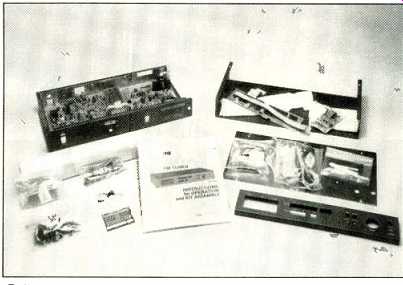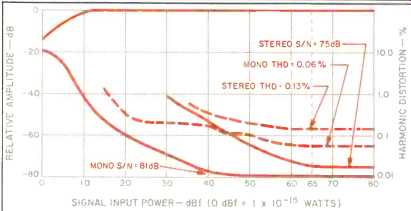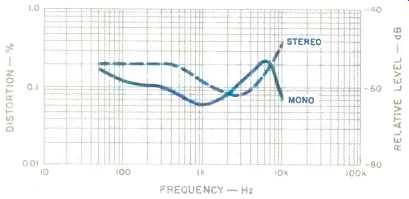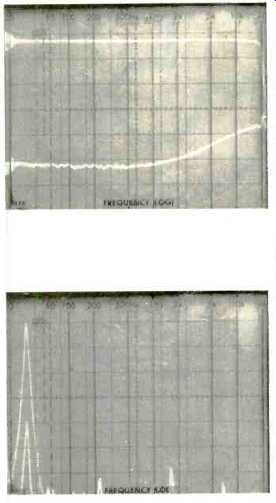
Manufacturer's Specifications:
Usable Sensitivity: 11.3 dBf.
50-dB Quieting Sensitivity: Mono, 17.2 dBf; stereo, 37.2 dBf.
THD: Mono, 0.1% at 1 kHz; stereo, 0.18% at 1 kHz.
S/N Ratio: Mono, 72 dB; stereo, 68 dB.
Capture Ratio: 1.5 dB.
Alternate-Channel Selectivity: 60 dB.
Dimensions: 17 in. W x 3 in. H x 8 1/2 in. D (43.2 cm x 7.6 cm x 21.6 cm).
Weight: 9 lbs. (4.1 kg).
Price: $460: $385 in kit form.
Company Address: 5910 Crescent Blvd., Pennsauken, N.J. 08109.
David Hafler, one of the true pioneers in the world of high fidelity, continues to provide well-designed audio components which offer outstanding value when purchased in wired form, and which offer substantial additional savings if you are willing to put in the time and effort to assemble them from a kit. The latest FM tuner to come from Hafler's company is the DH-330, an FM-only unit featuring a quartz-con trolled, digitally synthesized tuning system, five station pre sets, and automatic and preset-scan tuning. Hafler has also come up with interference-reduction circuitry which he calls an "AutoFilter." This circuit, automatically activated when noise or multipath interference is excessive, dynamically limits high-frequency separation and response in proportion to the amount of interference present in the signal. In the presence of a strong, interference-free signal, however, this special circuit is completely out of the audio path.
The front end of the DH-330 employs a triple-tuned circuit between the r.f. stage and the mixer, in addition to a tuned antenna circuit. The r.f. stage and mixer semiconductors are dual-gate MOS-FETs, and another dual-gate MOS-FET is used as a buffer between the mixer and the local oscillator stage to prevent "pulling" of the oscillator by strong signal modulation. A delayed AGC circuit allows the tuner to handle high-level antenna inputs. The i.f. stages employ four ceramic filters and have a flat group-delay characteristic and good phase linearity.
Control Layout
Like so many other Hafler products over the years, the DH-330's front panel is clean and uncluttered. The "Power" switch and a headphone jack are located at the extreme right, and a master "Volume" control is to their left. The volume control affects both phone and rear-panel line out put levels, but is intended primarily for use with phones. To the left of the volume control are four small buttons. One of these turns interstation muting on and off. A second button, when pushed, raises muting sensitivity to 31 dBf, so that when you use the automatic tuning mode the system will not stop at weaker stations. The "AutoFilter" feature, described earlier, is turned on and off by the third button, and the fourth is used to switch to mono reception if a given station's stereo signal is too weak to yield adequate signal-to-noise levels.
Five preset buttons; a preset "Store" button; "Auto," "Scan," and "Manual" (up and down) tuning buttons, and a "Halt" button (used to stop the scanning when you hear a station you want to lock in) are found near the center of the panel. The left end contains a multi-purpose display area with indicators for signal strength (five LEDs are used for this purpose), stereo reception, and frequency. A 50-kHz indicator LED supplements the frequency readout, indicating a half-step higher than the numerical reading shown in megahertz to the nearest tenth. In the U.S., where stations are spaced at odd tenths of a megahertz, this half-step indicator would normally not be very useful. However, in the rare cases where a particular station is hard to tune to without interference, it is sometimes helpful to tune slightly off the assigned frequency, and this extra indication helps to do that properly. In addition, many cable companies that carry FM transmissions often position them (deliberately or unknowingly) at frequencies which are a bit off the standard channel allocation points assigned by the FCC for broad cast purposes.
Kit Construction
Even if you've never assembled an electronic kit before, have no fears about building this tuner. The really difficult part of the wiring--assembly and soldering of the four major circuit boards--has already been done by Hafler. Further more, the mounted r.f., i.f., and multiplex decoder sections have been carefully aligned. Your part of the assembly work consists of 62 easy-to-follow steps having to do primarily with p.c. board mounting, power-supply wiring, and inter-wiring of the p.c. boards. Excellent pictorial diagrams are provided, and if you can resist the temptation to skip certain instructions which seem overly obvious and follow the steps exactly as listed, I can practically guarantee that the tuner will work the first time you turn it on.

Following only 62 steps turns this kit into a finished tuner,
thanks to pre-wired, pre-aligned circuit boards.
Of course, there is always a possibility that you may have done something wrong while assembling the tuner, or that a part (other than those mounted in the pretested p.c. boards) may be bad. For such situations, Hafler maintains a Technical Services Department that can help you by phone, or you can send the tuner back to Hafler along with $35. If the fault is with a part, they will replace it and return your money, less shipping charges. If the fault is yours, they will try to find it, send your unit back to you in working order, and keep your $35 for their trouble. If the problem was minor and took little time to spot and repair, they may even refund part of your money. I can't imagine a fairer deal than that.
I didn't assemble the tuner that I tested in my lab. That task was completed--rather neatly, I must say--by Richard L. Lerner of Phoenix, Arizona.
Measurements
Figure 1 shows the quieting and distortion characteristics of the finished FM tuner as a function of signal input levels.
Usable sensitivity in mono measured 10.8 dBf, and in stereo it was 22.0 dBf. For strong (65-dBf or greater) input signals, the signal-to-noise ratio was a very high 81 dB; in stereo, best S/N measured 75 dB. Both of these S/N values are considerably better than claimed in Hafler's published specifications. When you consider the fact that this tuner was assembled from a kit, with pre-aligned p.c. boards, these excellent results are even more remarkable. I was equally impressed with the low distortion readings obtained.
In mono, mid-frequency THD measured only 0.06%, and stereo THD measured 0.13%.
Figure 2 shows plots of harmonic distortion versus modulating frequency. At 100 Hz, THD measured 0.19% in mono and 0.2% in stereo. At 6 kHz, mono THD was 0.22% while stereo THD was actually a bit lower, only 0.16%.
Figure 3 is my usual spectrum analyzer 'scope photo showing frequency response and stereo separation. Response was flat to within 0.5 dB from 30 Hz to 15 kHz.
Separation at mid-frequencies measured just over 50 dB. At 100 Hz, stereo separation was 47 dB; at 10 kHz, it de creased to 37 dB. Figure 4 shows the crosstalk and distortion components that appear at the output of the unmodulated stereo channel when a 5-kHz audio signal is used to 100% modulate the opposite channel. The tall spike at the left represents desired output from the left, modulated channel and the shorter spike within the taller one represents the 5-kHz crosstalk appearing at the right-channel output. Further to the right you can see additional, well-attenuated spikes which represent residual 19-kHz pilot crosstalk, 38-kHz subcarrier crosstalk, and some very low-level distortion products. The crosstalk components observed here are, for the most part, lower than those observed with many more costly, factory-wired tuners I have tested in recent months.
Capture ratio for the DH-330 measured 1.3 dB and alternate-channel selectivity measured 65 dB. Image rejection was a high 85 dB, i.f. rejection measured 90 dB, AM suppression was in excess of 55 dB, and spurious response rejection was better than 90 dB.

Fig. 1-Mono and stereo quieting and distortion characteristics.

Fig. 2-THD vs. modulating frequency.

Fig. 3-Frequency response (upper trace) and separation vs. frequency.
Fig. 4-Crosstalk and distortion components for a 5-kHz modulating signal.
========Sidebar=========
FENITOWATTS TAKE OVER
Way back in 1975, the Institute of Electrical and Electronic Engineers (IEEE) and the Institute of High Fidelity (IHF) adopted a Standard for testing and measuring the performance of FM tuners and receivers. With the merging of the IHF into the Electronic Industries Association (EIA), that broader based organization adopted the same Standard.
One of the points of confusion that the Standard sought to address and correct was the question of how to state signal strengths. For many years manufacturers talked about the sensitivity of their FM tuners by quoting the number of microvolts requited at the FM antenna terminals to achieve a given degree of noise quieting or lowering of distortion. Unfortunately, noise quieting in an FM tuner varies with signal power applied at the antenna terminals, and power, though directly related to voltage, is also a function of the antenna input impedance across which the voltage is applied.
For example, suppose you apply 1 V across a resistive impedance of 10 ohms. Ohm's law tells us that the power developed across that impedance will be E2/R, where E is the voltage applied and R is the resistive impedance. The input power in this case would be 12/10, or 0.1 watt.
Now suppose the same 1 V were applied across a resistive impedance of 20 ohms. The power developed would now be only 12/20, or 0.05 watt-half as much as before. Yet the voltage applied is exactly the same as in the first example.
Relating that problem to FM tuners and receivers, you may have noticed that some tuners (mostly home units) have antenna input impedances of 300 ohms, while others (notably car-stereo tuners) have antenna input impedances of 75 ohms. Still other tuners may have both types of antenna inputs. Suppose that a tuner manufacturer whose product offers only a 300-ohm impedance claims a usable sensitivity of 2.0 µV. Another tuner maker, though fully as honest as the first one, happens to make a tuner with a 75-ohm antenna input, and that maker also claims a sensitivity of 2.0 uV If you go through the calculations of power required by each tuner to reach usable sensitivity, you'll quickly see that the 75-ohm tuner actually needs twice as much power as the 300-ohm tuner. To put it another way, the tuner with the 75-ohm is not nearly as sensitive as the other. Yet, so long as manufacturers continued to quote sensitivity in microvolts, a consumer might well take them both to have equal sensitivities.
Obviously, a solution to the problem would be to express signal inputs in power rather than in voltage values. However, the watt would be too large a unit to use for such a specification, so the IEEE and the IHF decided to use the femtowatt instead.
One femtowatt is equal to 1 x 10^-15 watt, or a decimal point followed by 15 zeros and a 1! To avoid the bur den of having to count zeros, it was decided to use a decibel or dB reference as a starting point; that is how the term dBf (dB with respect to 1 femtowatt) was born.
Once sensitivity is expressed in terms of power, it doesn't matter what the input impedance is; 10 dBf is the same amount whether you are dealing with a 75-ohm, a 300-ohm, or any other input impedance. Unfortunately, old habits die hard.
Manufacturers were slow to adopt the new terminology. Gradually, some began to list dBf ratings, at first in parentheses along with the "primary' microvolt ratings. As the years passed, the microvolts went inside the parentheses while the dBf figures came outside where they belong. To day most manufacturers of FM tuners have stopped quoting the confusing and misleading microvolt values altogether.
So long as the "dual rating" system persisted. Audio showed both micro volt and dBf values on graphs depicting quieting and harmonic distortion as a function of input signal strength.
Beginning with this test report, however, we are finally going to drop the microvolt scale at the top of those graphs (see Fig. 1) and confine ourselves to the unambiguous dBf scale along the bottom. For those few manufacturers who insist upon using microvolts and for those readers who still find it tough to think in terms of dBf, I offer four formulas to help you convert from of one form measurement to the other.
To convert from microvolts, across a 300-ohm load impedance. into dBf:
uf = 20 x log10(µV/0.55).
To convert from microvolts, across a 75-ohm load impedance, into dBf:
dBf = 20 x log10(uV/0.275).
To convert from dBf back to micro volts across a 300-ohm load impedance:
uV= 0.55 x log10 1(dBf/20).
To convert from dBf back to micro volts, across a 75-ohm load impedance:
uV= 0.275 x log10^-1 (dBf/20).
-Leonard Feldman
=================
Use and Listening Tests
At its price, the DH-330 offers everything that I would expect by way of good FM reception, and more. A simple wire dipole antenna is included, as is a 300-ohm/75-ohm transformer for those who want to use a coaxial signal input cable. However, Hafler wisely suggests using an outdoor antenna to realize this well-designed tuner's full capabilities, and I followed that advice. With a good directional outdoor antenna I was able to receive some 53 satisfactory signals at my location, with all but three of them quiet enough to be enjoyed in stereo. When I allowed the "AutoFilter" circuit to do its thing, two of those three became listenable as well, and the loss of separation was hardly noticeable.
I like the way Hafler has arranged the automatic-tuning feature of the DH-330. The scanning speed is just right, and the 4- to 5-S pause at each station is just long enough to let you decide if that's the station you want to listen to. I have a similar feature in my car-stereo system, but I am always somewhat bothered by the fact that automatic tuning can only be done in one direction-up the dial. If you missed locking in a station at 106.5, for example, you have to wait until the tuner gets up to 107.9 and then begins again from 88.1, or else go back to manual tuning. Hafler has solved that minor irritation by letting you auto-tune in both directions. To scan down the dial, you press the "down" manual-tuning button and then "Auto"; pressing the "Auto" button alone will result in a scan up the dial.
Another nice feature I discovered while using the tuner was its ability to recall a previously listened-to station when power is turned off and then on again, providing you push the "Halt" button before turning off the set. In addition to searching for stations with the "Auto" button, you can scan through your five memorized preset stations as well, using the "Scan" button. The memory used for retaining the five desired station frequencies is nonvolatile. This means that even if the a.c. power plug is pulled or there is a power failure or interruption, the DH-330 retains its memory. Hafler states that it will retain its memory "for years." I couldn't verify that claim, but I'm willing to bet that you will enjoy outstanding FM sound quality and performance "tor years" if you choose to build, or buy already wired, a DH-330.
-Leonard Feldman
(Audio magazine, Nov. 1986)
Also see:
Heath Model AJ-1510 Digital FM/FM Stereo Tuner (May 1972)
Hafler Iris FM Tuner (Feb. 1990)
Nikko Gamma I Stereo FM Tuner (May 1979)
Onkyo T-9090II FM Tuner (Jul. 1988)
Optonica ST-3636 AM/FM Stereo Tuner (Dec. 1978)
McIntosh Model MR-78 FM/Stereo, FM Tuner (Feb. 1977)
= = = =